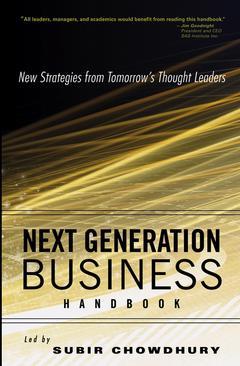Next Generation Business Handbook New Strategies from Tomorrow's Thought Leaders
Coordonnateur : Chowdhury Subir

* Presents fresh ideas from the young, up-and-coming business thinkers and experts from the world's best business schools.
* Coverage of topics like career imprinting and operating in a virtual workspace that are receiving increased attention in organizations.
* Organized around Chowdhury's "next generation business model."
Acknowledgments.
SECTION I: LEADERSHIP.
Introduction.
Part One: Leadership and the Business Environment.
1. The Effective Leader.
2. Using Organizational Culture as a Leadership Tool.
3. Leadership and Innovation.
4. Leadership and Destructive Self-Confidence.
Part Two: Leadership and Learning.
5. Leading by Analogy.
6. Career Imprinting and Leadership Development.
Part Three: Leadership and Employees.
7. Leading by Doing.
8. Leadership to Improve Performance.
9. Managing Leadership Images.
Part Four: Leadership and the Workplace.
10. Leadership in the Virtual Workplace.
11. Leadership in a Branded World.
12. Managing a Self-Managed Team.
13. The Merchandising of Leadership.
SECTION II: STRATEGY.
Introduction.
Part One: Strategies for Competitive Advantage.
14. Quality Strategy.
15. Competing on Social Capabilities.
16. Dynamics of Competitive Interaction.
17. Strategic Advantage and the Dynamics of Organizational Competence.
Part Two: Strategic Planning and Renewal.
18. To Plan or Not to Plan?
19. Mastering Strategic Renewal.
Part Three: Strategies for the Networked Economy.
20. Value Creation in the Networked Economy.
21. Global Strategy in an Internet Era.
Part Four: Strategies for Business Expansion.
22. Symbiosis or Parasitism?
23. Globalization and Management Attention.
Part Five: Strategies for Nonprofit Organizations.
24. Strategy Dynamics for Nonprofit Organizations.
SECTION III: CUSTOMER MANAGEMENT.
Introduction.
Part One: Relating to the Customer.
25. Understanding Customer Needs.
26. Strengthening Customer Relationships.
27. Building Customer Interface.
28. Avoiding Traps in Customer Relations.
29. Customer Relations Online.
Part Two: Experience with the Customer.
30. Customer Experience.
31. Coping with Critical Criticism.
32. Growing Pains.
33. Persuading with Emotions.
Part Three: Managing the Customer.
34. Strategic Customer Management.
35. Designing Supply and Distribution Channels.
36. Managing Global Customers.
SECTION IV: ENTREPRENEURSHIP.
Introduction One.
Introduction Two.
Part One: Entrepreneurial Behavior.
37. The Effective Entrepreneur.
38. Entrepreneurial Opportunities.
39. Nature of Entrepreneurship.
Part Two: Entrepreneurship and Finance.
40. New-Venture Finance.
41. Untangling Service-for-Equity Arrangements.
42. Business Planning.
Part Three: Entrepreneurship and Strategy.
43. Playing Entrepreneurial Judo.
44. Success for New Ventures.
Part Four: Entrepreneurial Management.
45. Entrepreneurial Mind-Set in Multinational Corporations.
46. Sustaining Rapid Growth.
Part Five: Entrepreneurship and Economics.
47. Income Disparity and Entrepreneurship.
SECTION V: PEOPLE MANAGEMENT.
Introduction.
Part One: People-Management Strategy.
48. Talent-Management System.
49. Living Strategy.
50. Changing Foundations of People Management.
Part Two: HR Management.
51. Returning Human to HR Management.
52. Change Management and HR Practices.
53. What Really Matters in HR Management?
Part Three: People and the Organization.
54. The Four Thrusts Driving Corporate Renewal.
55. Creating the Family-Friendly Organization.
56. Transforming the Process of Staffing toward Innovation.
57. How Old You Are May Depend on Where You Work.
58. Tomorrow’s Global Workforce.
SECTION VI: NETWORKED BUSINESS.
Introduction.
Part One: Organizations in the Networked ERA.
59. The Power of Networked Business.
60. Managing Networked Organizations.
61. Beyond ‘‘Synergies’’.
62. From Extended Enterprise to Orchestrating a Team of Companies.
63. Digital Networked Business.
Part Two: Network Strategy.
64. Strategic Connections.
65. Technological Mediation as Strategy.
66. Seamless IT Alignment.
67. Seizing the Value of Online Auctions.
68. Building a Platform for E-Business.
Notes.
About the Leader.
About the Next Generation Business Thinkers.
Author Index.
Subject Index.
Date de parution : 10-2004
Ouvrage de 1344 p.
16.3x24.6 cm
Thème de Next Generation Business Handbook :
Mots-clés :
business schools, business thinkers, career imprinting, virtual workspace, Chowdhury



